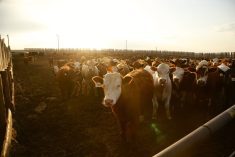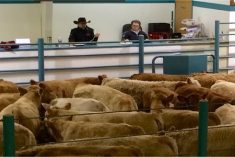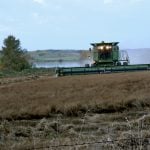Western Canadian feeder cattle price volatility continues while average prices remain near historical highs. Fancier minimal-flesh quality calf prices experienced spurts of $5 to $8 above average levels as exotic steers averaging 780 pounds reached up to $246 in central Alberta. Similarly, a small group of quality 750-lb. steers touched $252 at a feature sale in the Lethbridge area. Regular run-of-the-mill calves were trading $5 to $8 lower in some instances with anticipated stress levels accounting for the discount.
Adverse weather tempered buying interest at certain sales and feedlots are slowly filling up to comfortable levels for the winter period. Overall, feeding margins in southern Alberta are near $170 per head, which kept buying interest at unprecedented levels.
Read Also

U.S. livestock: Cattle futures mixed
Cattle futures on the Chicago Mercantile Exchange were mixed on Thursday, after dropping sharply the previous session. The December live…
Feedlot operators are shopping for the efficient gainers regardless of breed quality and pencils are sharper than ever. The returns have to justify the risk and the quality discernment can cause market changes over $10 for calves with similar weight at the same sale. Remaining yearling stragglers coming on the market at this time of year appeared to trade a bit softer, which is a major concern for backgrounding operators. Looking at the price structure between 600- and 850-lb. steers, the backgrounding operator with controlled weight gains is taking on the most risk and these smaller farmer/cattle feeders may be forced to finish animals this round.
Feed barley prices continue to percolate higher, trading at $188 per tonne delivered Lethbridge and feed wheat has also increased to $190 per tonne in the same region. Feed grain supplies are not as burdensome as earlier projected and further upside is anticipated over the winter. Record-high rail rates have tempered imports of U.S. corn and barley fundamentals are historically tight. Feedlots are sourcing barley from farther distances and a lack of farmer selling has strengthened barley prices.
Seasonally, fed cattle prices tend to strengthen late in the fourth quarter and U.S. beef production is expected to experience a sharper year-over-year decline over the next four months. However, fed cattle prices are at historical highs and wholesale beef values are stagnating causing packing margins to come under pressure. Seasonal swings can be more intense at record high prices which is a cause for concern during the slower consumptive period of January and February. There is no strong bias on either side of the feeder market and many factors can swing prices either way over the next couple months.
— Jerry Klassen is a commodity market analyst in Winnipeg and maintains an interest in the family feedlot in southern Alberta. He writes an in-depth biweekly commentary, Canadian Feedlot and Cattle Market Analysis, for feedlot operators in Canada. He can be reached by email at [email protected] for questions or comments.

















